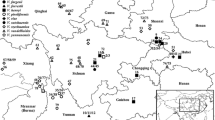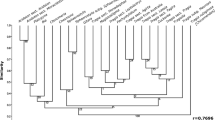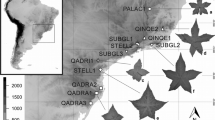Abstract
Adonis sect.Consiligo is split into three subsections based on morphology, growth pattern, pollen and fruit morphology. For all species distribution maps are provided and discussed with regard to their ecology and climatic requirements. These data reveal additional characters that support the classification of the taxa. Most species of the section grow in continental Eurasiatic steppes and mountain steppe habitats. Only the species of subsect.Amurenses grow in Far Eastern temperate forests and prefer a more oceanic climate. The taxonomic position of these strongly divergent species is supported by the distributional and ecological data. The evolution ofAdonis sect.Consiligo occurred under strong climatic control. During evolution the taxa could only slightly widen their ecological amplitude and, thus, ecology remained rather stable except that of the subsect.Amurenses. Ecological and distributional data can be used to validate taxonomy and phylogeny and reveal additional informations.
Similar content being viewed by others
References
Agroklimatičeskij atlas mira, 1972. — Moskva: Gidrometeoisat.
Bobrov, E. G., 1937:Adonis. — InŠiškin, B. K., (Ed.): Flora SSSR,7, pp. 528–539. — Moskow, Leningrad: Nauka.
Chrtek, J., Slavíková, Z., 1978: Gliederung der GattungAdonis in drei Gattungen. — Preslia50: 22–25.
ESRI, 1992: ARC/INFOTM. — Redlands.
Fisiko-geografičeskij atlas mira, 1964. — Moskva.
Gorovoj, P. G., Gursenkov, N. N., 1969: Novyi dlja flory SSSR vidAdonis ramosa Franch. i kritičeskie sametki po dalnevostočnym vidam. — Bot. Zhurn. (Moscow & Leningrad)54: 139–143.
Holmgren, P. K., Holmgren, N. H., Barnett, L. C., 1990: Index herbariorum. 8. edn. — New York: New York Botanical Garden. Regnum Veg.120.
Jäger, E. J., 1988: Möglichkeiten der Prognose synanthroper Pflanzenverbreitungen. — Flora180: 103–131.
—, 1990: Pflanzenareale als Leistungsgrenzen. — Biol. Rundschau28: 295–306.
—, 1992: Die Verbreitung vonFrankenia in der Mongolei, in Westeurasien und im Weltmaßstab. — Flora186: 177–186.
—, 1995: Klimabedingte Arealveränderungen von anthropochoren Pflanzen und Elementen der natürlichen Vegetation. — Angew. Landschaftsökol.4: 51–57.
Krylov, P., 1931: Flora zapadnoi sibiri.5. — Tomsk.
Kučerov, E. V., Muldašev, A. A., Galeeva, A. C., 1993: Ekologo-cenotičeskaja charakteristkaAdonis vernalis L. na južnom urale. — Rast. Res.29(2): 11–16.
Kullman, L., 1979: Change and stability in the altitude of the birch tree limit in the Southern Swedish Scandes. — Acta Phytogeogr. Suec.65: 1–121.
—, 1991: Cataclysmic response to recent cooling of a natural boreal pine forest in northern Sweden. — New. Phytol.117: 351–360.
—, 1993: Holocene thermal trend inferred from tree-limit history in the Scandes Mountains. — Global Ecol. Biogeogr. Lett.2: 181–188.
Meusel, H., Jäger, E., Weinert, E., 1965: Vergleichende Chorologie der zentraleuropäischen Flora.1. — Jena: G. Fischer.
Nowicke, J. W., Skvarla, J. J., 1995: Pollen morphology. — InEngler, A., Prantl, K., Harms, H., (Eds): Die natürlichen Pflanzenfamilien nebst ihren Gattungen und wichtigsten Arten, insbesondere der Nutzpflanzen. 2nd edn,17a IV. — Berlin: Duncker & Humblot.
Poškurlat, A. P., 1975a: Ontogenez goricveta solotistogo (Adonis chrysocyatha Hook. f. &Th. — Nauchnye dokl. Vyshei skoly Biol. Nauki4: 64–74.
—, 1975b: Bolšoj šiznennyj cikl goricweta vesennego. — Rast. Res.11: 483–492.
—, 1977: Systema sectionisConsoligo [sic] DC. generisAdonis L. — Novosti Sist. Vyssh. Rast.14: 82–83.
—, 1984: Morfologičeskie osobennosti i ontogenezAdonis amurensis Regel. — Rast. Res.20: 65–74.
—, 1991a: Uslovija obitanijaAdonis vernalis L. na raznych učastkach areala v evropejskoj časti SSSR. — Rast. Res.27(3): 47–54.
—, 1991b: Uslovija obitanijaAdonis vernalis L. na raznych učastkach areala v sibiri. Rast. Res.27(4): 20–27.
Tamura, M., 1991: A new classification of the familyRanunculaceae 2. — Acta Phytotax. Geobot.42: 177–187.
—, 1995:Ranunculaceae. — InEngler, A., Prantl, K., Harms, H., (Eds): Die natürlichen Pflanzenfamilien nebst ihren Gattungen und wichtigsten Arten, insbesondere der Nutzpflanzen. 2nd edn,17a IV. — Berlin: Duncker & Humblot.
UNESCO, 1970, 1975, 1980: Climatic atlas of Europe. Climatic atlas of North and Central America. Climatic Atlas of Asia. — Genf, Paris, Budapest: WMO, UNESCO, Cartographia.
Vasilčenko, T. I., 1979: Vlijanie vypasa na cenopopuljacii goricveta vesennogo na stepnych melovych sklonach v Kurskoj oblasti. — Rast. Res.15(2): 210–213.
Woodward, F. I., 1987: Climate and plant distribution. — Cambridge: Cambridge University Press.
Author information
Authors and Affiliations
Rights and permissions
About this article
Cite this article
Hoffmann, M.H. Ecogeographical differentiation patterns inAdonis sect.Consiligo (Ranunculaceae). Pl Syst Evol 211, 43–56 (1998). https://doi.org/10.1007/BF00984911
Received:
Revised:
Accepted:
Issue Date:
DOI: https://doi.org/10.1007/BF00984911




